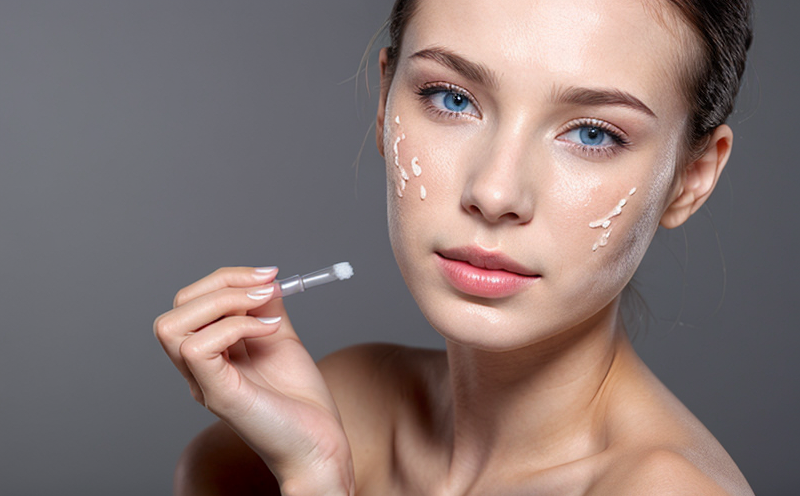Irritation Testing of Foundation and Powder Cosmetics
The irritation testing of foundation and powder cosmetics is a critical aspect of product safety in the cosmetic industry. As quality managers, compliance officers, R&D engineers, or procurement specialists, you are responsible for ensuring that your products meet strict regulatory standards and do not cause harm to consumers. This service involves assessing whether the cosmetic formulations could potentially irritate the skin when applied.
When testing foundation and powder cosmetics, it is important to consider several factors such as the type of ingredients used, their concentration, and how they interact with the skin. The primary goal is to identify any potential allergens or sensitizers that might cause adverse reactions in users. By conducting thorough irritation tests early in the development process, manufacturers can mitigate risks associated with harmful chemicals and improve overall product safety.
The testing procedure typically begins by selecting appropriate test subjects based on the intended user demographic for the cosmetic product being evaluated. These individuals are then asked to apply a small amount of the sample onto areas like their upper arms or backs under controlled conditions specified in relevant standards such as ISO 10993-18:2017. The application should simulate real-world use scenarios so that results accurately reflect actual performance.
After applying the test substance, observations are made over time to monitor for any signs of irritation or sensitization reactions. Common indicators include redness, swelling, itching, burning sensations, or increased skin dryness at the application site after 24 hours and up to several days post-exposure. If significant adverse effects are observed during these periods, further evaluation may be necessary depending on the severity.
It is also essential to note that certain types of foundation and powders contain ingredients which could react differently across various skin tones or types due to their chemical composition or formulation properties. Therefore, it might be beneficial to test multiple shades if your product line targets diverse consumer bases. Additionally, understanding local regulations around cosmetics labeling can help ensure compliance while protecting brand integrity.
In summary, irritation testing plays an integral role in safeguarding public health by preventing the release of potentially dangerous products into markets. It allows companies to make informed decisions about ingredient selection and formulation adjustments before reaching final commercialization stages. Properly conducted studies not only protect end users but also enhance brand reputation through demonstrated commitment to safety standards.
Why It Matters
The importance of irritation testing cannot be overstated for several reasons:
- Consumer Safety: Ensures that products do not pose risks to consumers, particularly those with sensitive skin.
- Regulatory Compliance: Adheres to international standards such as ISO 10993-18:2017 which outlines requirements for biocompatibility assessment including irritation evaluations.
- Risk Mitigation: Identifies problematic ingredients early in the development process allowing manufacturers to address issues promptly and avoid costly recalls later on.
- Brand Reputation: Demonstrates a strong commitment to quality assurance, enhancing consumer trust and loyalty towards your brand.
- Legal Protection: Reduces liability exposure by providing evidence of due diligence in product development and safety evaluation processes.
Given the complexities involved with modern cosmetic formulations, comprehensive irritation testing is crucial for ensuring both efficacy and safety across all marketed products. This approach helps maintain high standards throughout the supply chain from raw materials sourcing to finished goods distribution.
Quality and Reliability Assurance
Ensuring quality and reliability in cosmetic product development requires rigorous adherence to established protocols during each phase of manufacturing—from formulation design through final packaging. For irritation testing specifically, this involves carefully selecting suitable test subjects representing typical end users, applying the sample under controlled conditions, and monitoring for any adverse reactions over specified timeframes.
One key aspect of quality assurance is ensuring that all tests are conducted using accurate instruments calibrated according to industry best practices. This helps guarantee consistent results across multiple batches or lot numbers produced by different facilities. Additionally, maintaining strict documentation throughout the entire testing process allows easy traceability and verification should any discrepancies arise during later audits.
Reliability in irritation testing further extends beyond just meeting regulatory requirements; it encompasses long-term stability studies that assess how well a given formulation holds up against environmental factors such as temperature fluctuations or humidity levels. Understanding these variables helps determine optimal storage conditions for maintaining product integrity over extended periods without compromising quality standards.
In conclusion, incorporating robust quality and reliability measures into irritation testing ensures not only compliance with current regulations but also prepares companies to anticipate future changes in legislation while upholding their reputation among customers.
International Acceptance and Recognition
The global nature of the cosmetic industry means that many countries recognize and accept internationally accepted standards for irritation testing. One such standard is ISO 10993-18:2017, which provides guidance on biocompatibility assessment including irritation evaluations.
ISO 10993-18 specifies a series of tests aimed at identifying potential irritants in cosmetic products. These include but are not limited to patch testing, occlusive patch testing, and open application tests. The choice of test depends on the specific formulation being evaluated as well as its intended use.
Another internationally recognized standard is the European Union's Cosmetics Regulation (EC) No 1272/2008, which incorporates parts of ISO standards into its framework. This regulation requires manufacturers to conduct irritation tests on new cosmetic ingredients and finished products before placing them onto EU markets.
Additionally, some regions may have additional local regulations or guidelines that supplement these international standards. For example, Japan has its own set of criteria outlined in the Japanese Pharmacopoeia for evaluating cosmetics for safety and efficacy. Similarly, Australia/New Zealand follows specific protocols based on their own national health authorities' recommendations.
Overall, adherence to recognized international standards not only ensures consistent quality across borders but also facilitates smoother trade between different countries by reducing barriers due to varying regulatory requirements.





